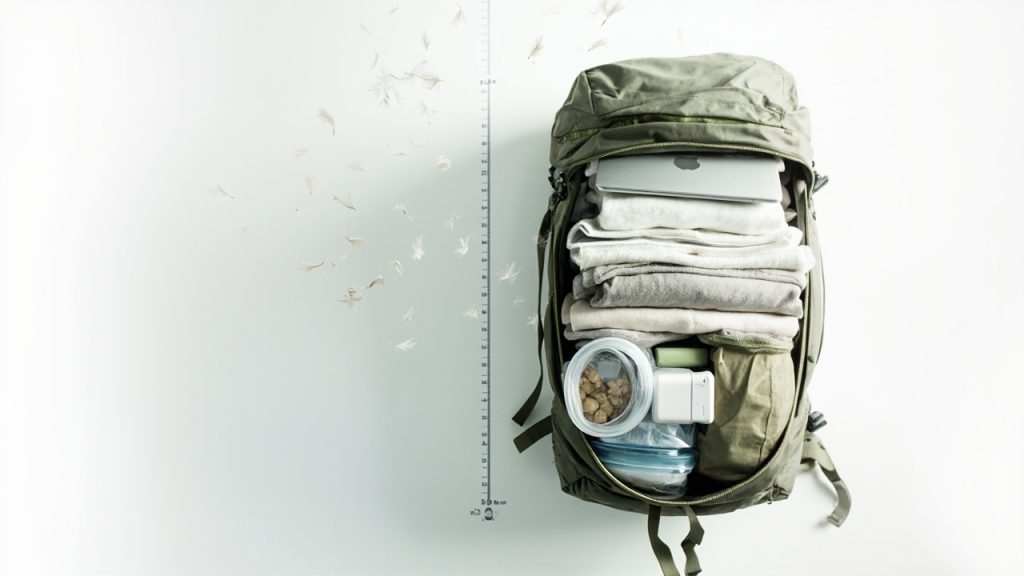Picture this: you’re standing in an airport security line, effortlessly lifting your 7kg backpack with one hand while watching other travelers struggle with oversized suitcases. That’s the reality of mastering an ultralight packing list. For digital nomads and minimalist travelers, achieving the perfect balance between necessity and weight isn’t just about convenience—it’s about transforming your entire travel experience.
The art of ultralight travel goes beyond simply throwing fewer items in your bag. It requires strategic thinking, quality gear selection, and a deep understanding of what truly matters on the road. Whether you’re embarking on a three-month Southeast Asian adventure or settling into your latest digital nomad destination, your ultralight packing list becomes your gateway to unprecedented freedom and mobility.
This comprehensive guide will walk you through the science-backed strategies and practical techniques that seasoned nomads use to maintain a sub-7kg pack without sacrificing comfort or style. You’ll discover weight-cutting secrets that took professionals years to perfect, along with common mistakes that could be secretly adding kilograms to your load.
Why Your Ultralight Packing List is the Key to Freedom (and Your Back Will Thank You)
The benefits of ultralight travel extend far beyond the obvious physical advantages. According to research published in the Journal of Sports Medicine and Physical Fitness, carrying loads exceeding 10-15% of body weight significantly increases fatigue and reduces mobility efficiency. For a 70kg traveler, this means keeping your pack under 7-10.5kg isn’t just convenient—it’s physiologically optimal.
Freedom of movement represents the most compelling advantage of ultralight travel. With a properly designed ultralight packing list, you can navigate crowded train stations, climb hostel stairs without breaking a sweat, and make spontaneous travel decisions without the burden of heavy luggage. This agility proves invaluable when catching last-minute flights, exploring destinations on foot, or simply moving through your daily nomadic routine.
Financial benefits also play a crucial role. Airlines increasingly implement strict weight restrictions and hefty excess baggage fees. Budget carriers like Ryanair and AirAsia charge up to $50 per additional kilogram, making your ultralight approach a significant money-saver over extended travel periods. Additionally, lighter packing often translates to smaller, less expensive accommodation options since you don’t require extensive storage space.
The psychological advantages shouldn’t be overlooked either. Minimalist travelers report reduced decision fatigue, decreased anxiety about lost luggage, and increased confidence in their ability to handle unexpected situations. When everything you own fits in a single, manageable pack, you develop a powerful sense of self-reliance that enhances every aspect of your journey.
The Science Behind Ultra-Light Travel: What 7kg Really Means
The 7kg threshold isn’t arbitrary—it’s based on biomechanical research and practical airline restrictions. Studies from the International Ergonomics Association demonstrate that loads under 10% of body weight can be carried comfortably for extended periods without significant postural changes or energy expenditure increases. For most adults, this translates to approximately 7kg as an optimal upper limit.
Airlines typically allow carry-on bags weighing 7-10kg, making this weight range strategically important for avoiding checked baggage fees and restrictions. Major carriers like Emirates, Singapore Airlines, and Lufthansa enforce strict weight limits, but staying under 7kg provides a comfortable buffer across virtually all airlines worldwide.
Metabolic efficiency research reveals fascinating insights about load carrying. The American College of Sports Medicine found that every additional kilogram increases energy expenditure by approximately 7% during walking activities. Over a full day of exploration, the difference between a 7kg and 15kg pack could mean expending 56% more energy—equivalent to the metabolic cost of walking an additional 3-4 kilometers.
Material science advances have revolutionized what’s possible within the 7kg constraint. Modern ultralight fabrics like Dyneema Composite Fabric (formerly Cuben Fiber) offer strength-to-weight ratios that were impossible just a decade ago. These innovations allow contemporary travelers to carry high-quality, durable gear that previous generations couldn’t imagine fitting in such lightweight packages.
Essential Ultralight Packing List Categories Every Nomad Needs
Successful ultralight packing requires systematic categorization and weight allocation. Professional nomads typically distribute their 7kg budget across five primary categories: clothing (2-2.5kg), electronics (1.5-2kg), toiletries (0.5-0.8kg), gear and accessories (1-1.5kg), and miscellaneous items (0.5-1kg). This framework ensures balanced coverage while maintaining strict weight discipline.
The clothing category demands the most strategic thinking within your ultralight packing list. Focus on versatile, quick-dry materials that can transition seamlessly between different climates and social situations. Merino wool base layers, convertible pants, and packable insulation pieces form the foundation of an efficient wardrobe system that maximizes utility while minimizing weight.
Electronics present both opportunities and challenges for digital nomads. Modern devices offer incredible functionality, but redundancy can quickly sabotage your weight goals. Essential items include a lightweight laptop (under 1.2kg), universal power adapter, smartphone, and necessary cables. Consider consolidating functions—your smartphone can replace a separate camera, GPS device, and entertainment system.
Gear and accessories encompass everything from your backpack itself to travel documents and emergency supplies. Invest in an ultralight pack weighing under 800g, use titanium or aluminum accessories where possible, and embrace digital alternatives for maps, guidebooks, and travel documents. Every gram counts in this category, so scrutinize each item’s necessity and weight contribution.
Clothing Strategies That Cut Weight Without Sacrificing Style
The key to ultralight clothing lies in layering systems and material selection rather than quantity reduction. Professional outdoor athletes and ultralight backpackers have perfected techniques that maintain comfort and style while dramatically reducing weight. Focus on pieces that serve multiple functions and can be mixed, matched, and layered for various weather conditions and social settings.
Base layer selection forms the foundation of your clothing system. Merino wool offers unmatched versatility—it’s naturally antimicrobial, temperature-regulating, and comfortable in both hot and cold conditions. A single high-quality merino shirt can be worn for multiple days without odor development, reducing the total number of pieces required in your ultralight packing list.
The “one week rule” provides practical guidance for clothing quantities. Pack enough clothing for one week, then commit to regular laundry cycles. This approach works globally since laundry facilities are available virtually everywhere. Quick-dry materials like synthetic blends or merino wool ensure items are ready to wear within hours rather than days.
Footwear represents a critical weight decision point. A single pair of hiking boots can weigh 800-1200g, consuming 12-17% of your entire weight budget. Instead, consider ultralight trail runners (300-500g) that can handle diverse terrain while remaining socially acceptable in urban environments. Add packable camp shoes or flip-flops (100-200g) for hostel showers and beach situations.
Strategic color coordination amplifies versatility without adding weight. Choose a cohesive color palette—typically two neutrals (black, navy, gray) plus one accent color—that ensures every piece coordinates with every other piece. This approach maximizes outfit combinations while maintaining a polished appearance suitable for both adventure and professional situations.
Tech and Electronics: The Ultralight Packing List for Digital Nomads
Digital nomads face unique challenges when optimizing their ultralight packing list for technology needs. Modern remote work requires reliable computing power, communication tools, and productivity accessories, yet electronics can quickly dominate your weight budget. The solution lies in strategic device selection and ruthless elimination of redundancies.
Laptop selection represents your most critical decision. Ultrabooks weighing under 1kg, such as the MacBook Air M2 or Dell XPS 13, provide professional-grade performance without overwhelming your weight constraints. Consider cloud-based workflows that reduce local storage requirements and enable smaller, lighter devices. Remember that every 100g saved on your laptop creates room for other essential items.
Power management demands sophisticated planning for nomadic lifestyles. A single GaN (Gallium Nitride) charger can power multiple devices while weighing significantly less than traditional chargers. Brands like Anker and RAVPower offer 65W chargers weighing under 120g that can handle laptops, phones, and accessories simultaneously. For extended outdoor adventures, consider integrating a solar laptop charger to maintain power independence without grid dependency.
Cable organization often gets overlooked but can add surprising weight to your pack. Replace heavy charging cables with lightweight alternatives—USB-C cables with braided nylon sheaths weigh 30-50% less than standard rubber-coated versions. Invest in a single high-quality multi-port cable that can charge multiple devices rather than carrying separate cables for each device.
Productivity tools should focus on enhancing your digital nomad workflow without adding physical weight. Cloud-based solutions for file storage, project management, and communication eliminate the need for additional hardware. Consider how digital nomad productivity tools can replace physical notebooks, calculators, and reference materials that might otherwise occupy precious pack space.
Toiletries and Personal Care: Minimalist Essentials That Actually Work
Personal care items often become hidden weight culprits in ultralight packing systems. The average traveler carries 1-2kg of toiletries, but strategic selection and repackaging can reduce this to under 500g without compromising hygiene or comfort. Focus on multi-purpose products and travel-sized alternatives that maintain effectiveness while minimizing weight and space requirements.
Solid alternatives revolutionize toiletry weight management. Solid shampoo bars, soap bars, and deodorant sticks eliminate liquid weight while lasting significantly longer than their liquid counterparts. A quality shampoo bar weighing 60g provides the equivalent of 350ml of liquid shampoo (weighing 350g), representing an 83% weight reduction with superior longevity.
The “hotel strategy” reduces toiletry loads for accommodation-based travelers. Many hotels and hostels provide basic amenities like soap, shampoo, and towels, allowing you to pack only specialized items unavailable at most accommodations. This approach works particularly well for urban digital nomads who rarely venture into remote areas lacking basic facilities.
Prescription medications require careful planning within your ultralight packing list. Obtain sufficient supplies for your entire journey plus a reasonable buffer, but avoid over-packing “just in case” medications. Consult with your physician about higher-concentration formulations that reduce pill counts, and research availability of common medications at your destinations to avoid unnecessary redundancy.
First aid essentials should focus on treating minor injuries and common ailments rather than preparing for major emergencies. A minimalist kit including adhesive bandages, antiseptic wipes, pain relievers, and anti-diarrheal medication weighs under 100g while addressing 90% of typical travel health issues. Extensive first aid supplies are better accessed through local healthcare systems rather than carried continuously.
Advanced Ultralight Packing List Techniques from Seasoned Travelers
Veteran ultralight travelers employ sophisticated techniques that go beyond basic item selection. These advanced strategies, developed through thousands of kilometers of experience, can help you achieve professional-level weight optimization while maintaining comfort and preparedness. Understanding these methods transforms good ultralight packing into exceptional weight management.
The “wear your heaviest” principle maximizes your weight allowance by strategically wearing rather than packing your heaviest items during transit. Boots, thick jackets, and heavy electronics can be worn or carried in pockets during flights, effectively adding 1-2kg to your available packing space without exceeding airline weight limits. This technique proves especially valuable when traveling between dramatically different climates.
Gear sharing strategies work exceptionally well for couples or travel partners. Split shared items like chargers, toiletries, first aid supplies, and tools across multiple packs to eliminate redundancy. One person might carry the universal adapter and cables while the other handles toiletries and medications. This collaborative approach can reduce individual pack weights by 15-20%.
Seasonal gear rotation involves strategically shipping or storing climate-specific items rather than carrying them continuously. Services like Shipstick or local storage facilities allow you to maintain access to specialized gear without permanent weight penalties. This technique works particularly well for nomads following predictable seasonal patterns or spending extended periods in specific climates.
The “weight diary” method involves tracking every item’s weight and usage frequency over several months. This data reveals patterns about which items truly earn their place in your ultralight packing list versus those that remain unused despite their perceived importance. Professional nomads often discover they use only 70-80% of their carried items regularly, providing clear targets for further weight reduction.
Common Ultralight Packing Mistakes That Add Hidden Weight
Even experienced travelers fall victim to subtle mistakes that gradually inflate their pack weight beyond optimal levels. These common errors often develop slowly over multiple trips, making them difficult to identify without systematic review. Understanding these pitfalls helps maintain long-term weight discipline and prevents the gradual “weight creep” that affects many long-term nomads.
Redundancy creep represents the most insidious weight-adding mistake. Over time, travelers accumulate multiple items serving identical functions—backup chargers, extra cables, duplicate tools, or similar clothing pieces. Regular gear audits should identify and eliminate these redundancies. Ask yourself: “If I could only carry one of these items, which would I choose?” The answer usually reveals which items are truly essential versus merely convenient.
The “what if” trap leads to overpacking for unlikely scenarios. While preparedness is important, carrying specialized gear for rare situations violates ultralight principles. Most “what if” scenarios can be addressed through local procurement, rental, or alternative solutions rather than permanent pack weight. Focus on preparing for probable situations rather than covering every possible contingency.
Souvenir accumulation destroys carefully maintained weight limits during extended travels. Set strict rules about souvenir collection—consider digital alternatives like photos, or commit to shipping items home rather than carrying them. Some nomads implement a “one in, one out” policy where acquiring new items requires discarding equivalent weight from existing gear.
Ignoring actual usage patterns versus perceived needs creates significant weight inefficiencies. Many travelers carry items they believe they’ll use frequently but actually rarely need. Track your actual usage over several weeks to identify items that consistently remain unused. These items become prime candidates for elimination in your next ultralight packing list iteration, regardless of their theoretical utility.
Mastering an ultralight packing list under 7kg isn’t just about reducing weight—it’s about fundamentally transforming your travel experience. The freedom to move effortlessly between destinations, the confidence that comes from true mobility, and the mental clarity of owning only what you truly need creates a level of travel satisfaction that many never experience.
The techniques and strategies outlined in this guide represent years of collective wisdom from professional nomads, outdoor athletes, and minimalist travelers. From understanding the biomechanical science behind optimal load carrying to implementing advanced weight-cutting techniques, you now possess the knowledge to create a truly efficient packing system that serves your specific travel style and needs.
Remember that ultralight packing is a skill that improves with practice and experience. Your first attempt might not achieve the perfect 7kg target, but each journey provides opportunities to refine your system, eliminate unnecessary items, and discover new weight-saving techniques. The key is maintaining commitment to the principles while remaining flexible enough to adapt based on real-world usage patterns.
Start implementing these strategies on your next journey, whether it’s a weekend getaway or a months-long nomadic adventure. Your back, your wallet, and your sense of freedom will thank you for making the commitment to true ultralight travel. The path to nomadic independence begins with a single, perfectly optimized pack.



